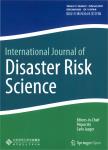Information for Disaster Preparedness: A Social Network Approach to Rainwater Harvesting Technology Dissemination
Information for Disaster Preparedness: A Social Network Approach to Rainwater Harvesting Technology Dissemination作者机构:Disaster Prevention Research InstituteKyoto UniversityGokashoUjiKyoto 6110011Japan Institute for Sky Water Harvesting1201-2 FukasawaGotemba CityShizuoka Prefecture 4120023Japan Institute for the Research of Disaster Area ReconstructionKwansei Gakuin UniversityHyogo 6628501Japan
出 版 物:《International Journal of Disaster Risk Science》 (国际灾害风险科学学报(英文版))
年 卷 期:2014年第5卷第2期
页 面:95-109页
核心收录:
学科分类:082802[工学-农业水土工程] 0709[理学-地质学] 08[工学] 0303[法学-社会学] 0832[工学-食品科学与工程(可授工学、农学学位)] 083002[工学-环境工程] 0830[工学-环境科学与工程(可授工学、理学、农学学位)] 1201[管理学-管理科学与工程(可授管理学、工学学位)] 0828[工学-农业工程] 0708[理学-地球物理学] 0705[理学-地理学] 0837[工学-安全科学与工程] 0706[理学-大气科学] 0813[工学-建筑学] 0704[理学-天文学] 0833[工学-城乡规划学]
主 题:disaster harvesting tank
摘 要:Rainwater harvesting technology is considered an innovative and effective mechanism for reducing drinking water risks due to arsenic contamination and water salinity in coastal Bangladesh. However, adoption of such tanks remains elusive. Most studies on disaster risk communication are predominantly based on individuallevel cognitive modeling approaches, which fail to address the role of social groups, human relations, and other collective social factors in the dissemination process of disaster preventive measures. From the viewpoint of social implementation, community adoption of unfamiliar technology for disaster risk mitigation and preparedness requires another approach. Given the challenge to promote rainwater harvesting technology in the study area of coastal Bangladesh, this study examines the role of various social networks including cohesive groups(friends), structural equivalent groups(individuals who have the same position in society), and spatial groups(neighbors) in three information sharing and processing activities—hearing, observation, and discussion. Results show that those individuals who have similar cohesive affiliations tend to become hearing and discussion partners. Cohesive groups share a learning opportunity and are bounded by normative constraints in terms of direct and intimate social *** groups facilitate observation, which provides visual learning. Structurally equivalent groups are not relevant in adoption dissemination;therefore competition or similar social environment did not influence the rainwater tank dissemination activities.



